Maintaining competitiveness is inextricably linked to increasing efficiency, often understood as speed of execution. The problem, however, is usually maintaining accuracy. A common response to this is to introduce the latest technologies into manufacturing and service processes. The right solutions increase productivity while reducing costs. Naturally – companies that introduce them first can quickly leave competitors behind.
An example of a technology whose introduction can make a difference to a company’s future is industrial robots. The exact figures, of course, depend on the specific application, but general estimates suggest that introducing a robot to perform one key task in a production line can increase productivity by up to 40%. Simply put, robots can increase speed, accuracy, reliability and repeatability. They also generally use less space in the production space than a conventional workstation. Thanks to technological developments, robots have become affordable even for small and medium-sized businesses. They are fast, compact and can be set up to interact with traditional automation or support processes performed by employees. This makes them easy to implement and use. But what can they actually do? Which processes should be robotized first? How should the layout of the production space be rearranged? What about scalability? Today’s robots are available in sizes suitable for handling objects ranging from a few grams to several thousand kilograms. Popular types include SCARA robots, Cartesian robots, and single- or multi-axis robots, which can be used in stand-alone applications dedicated to a single process or as groups carrying out successive processes. Yamaha’s YK-XG SCARA robot has been applied to the REECO Robots series.
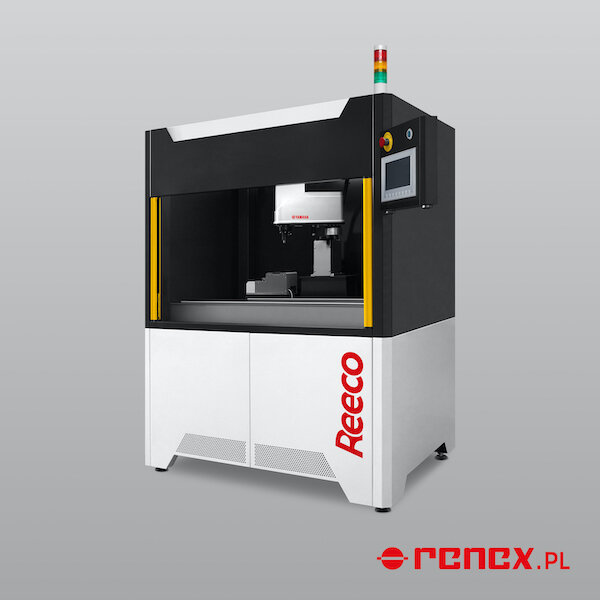
From one to multiple processes
YAMAHA has extensive and long-standing experience in production automation in many industries. The industrial robots it supplies, particularly the SCARA type, are well suited for a wide range of assembly processes. An excellent example of their implementation is the REECO Robot series. The devices included in it allow you to automate a specific process, such as soldering, screwing, dispensing or applying protective coatings. In the REECO Robot series, the YAMAHA SCARA YK-XG manipulator has been integrated with, among other things, a conveyor and safety cage, creating a turnkey solution that can be quickly installed in an industrial plant. The device can operate both in-line and off-line. In the latter case, workpieces can be fed in manually or via a feeder. REECO robots allow manufacturers to introduce robotic technology into their factories in a flexible and scalable manner. Processes previously performed manually, such as soldering wires or through-hole components, tightening screws to a specific torque, batching or applying coatings, can be individually automated to provide greater speed, repeatability and predictable cycle times.
REECO Dosing Robot
The REECO Dosing Robot is a ready-to-implement device that allows automatic and precise application along a predetermined path of substances (media) of different densities such as adhesives, gaskets, paints, lubricants and others of similar consistency. The object on which the substance is to be applied is introduced into the working field, where the head, equipped with a suitably selected nozzle, distributes the substance according to the programmed scheme and in precisely measured quantities.
This makes the process independent of the operator’s manual skills and allows for accuracy and repeatability that the human hand is not capable of. All of this minimizes the costs and process problems associated with applying too little or too much of a substance – particularly leakage and the resulting dirt. As a result, robotization speeds up the process, minimizes wear and tear on the applied substances themselves, and reassures the user that products are produced with the highest possible precision.
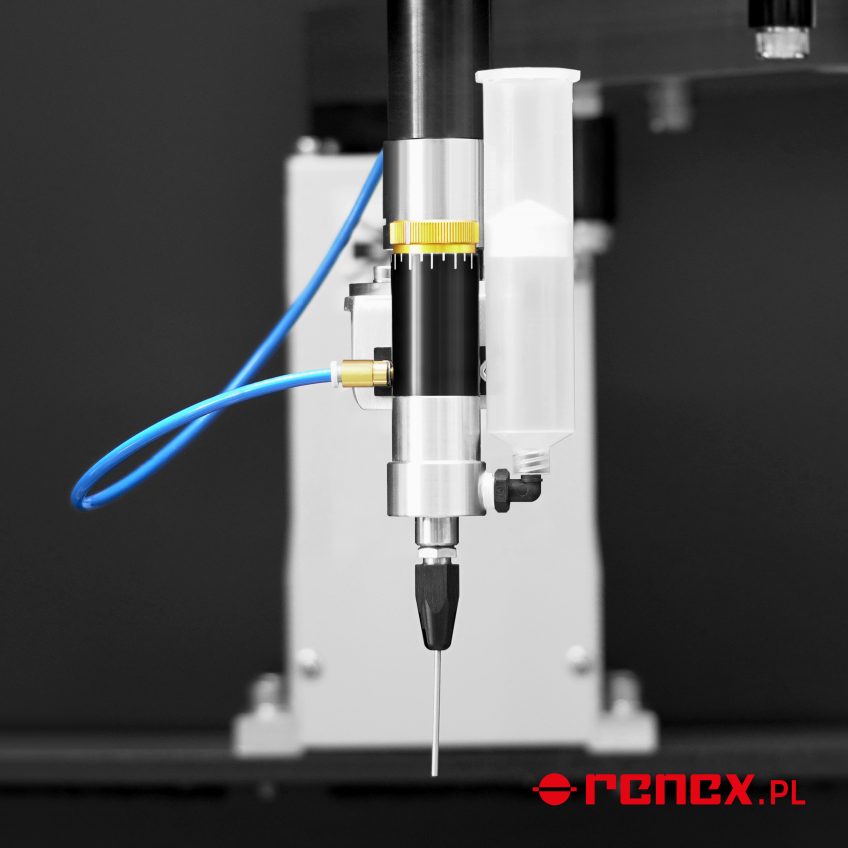
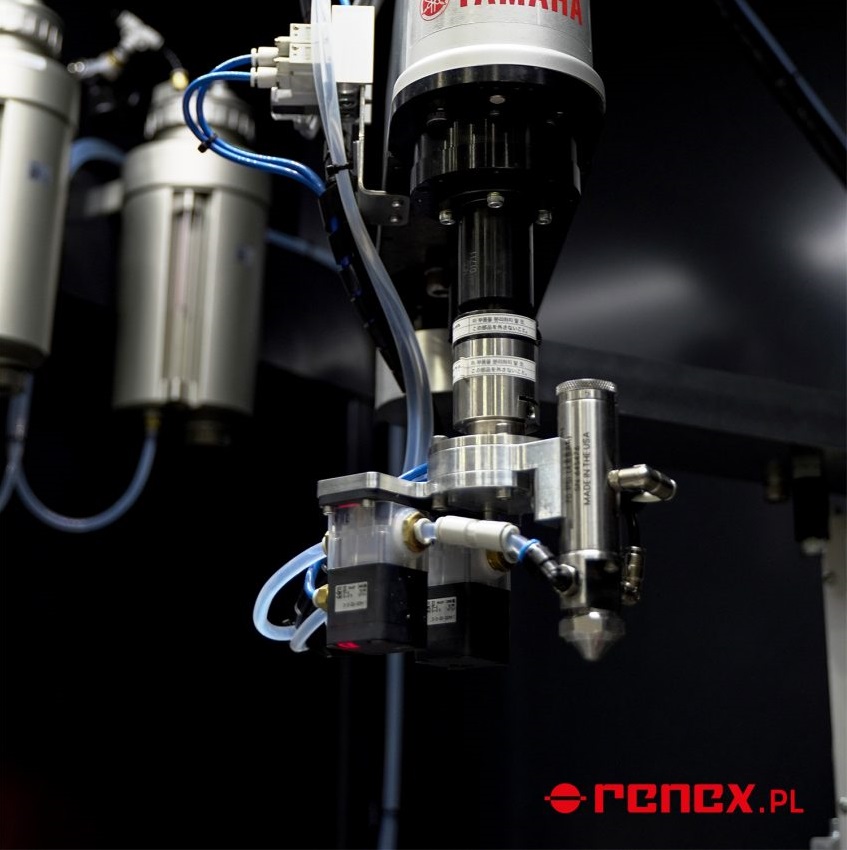
REECO Coating Robot
The Coating Robot is a new device in REECO’s product range responding to market demand in the sphere of automation of the conformal coating process. However, the device allows for the automation of production steps involving the spray distribution of various liquids.
The machine is equipped with a spray valve to ensure even application of liquid coatings of low to medium viscosity and an innovative integrated nozzle cleaning system that eliminates the problem of manually cleaning the valve.
A distinguishing feature of the device is the ability to freely configure the dispensing systems and dispensing valves on the robot head. This allows it to be tailored to the specific application and materials (media) to be distributed. Up to three different valves can be mounted on the head of the device. This gives the possibility of simultaneous dispensing of up to three media, increasing efficiency and reducing the time of a single cycle. The device can be optionally equipped with traceability software that collects statistical data in the course of ongoing projects.
Soldering robot
The REECO soldering robot allows for the automation of the assembly of through-hole components on PCBs. Relative to alternative solutions, the robot has low power consumption and does not require carriers of expensive materials, nitrogen shielding, or washing of the flux used in the soldering process. This makes cost-effective with its use already small- and medium-volume production.
The design is based on a soldering head with a binder feeder mounted on a YAMAHA SCARA robot. This allows the creation of precise solder joints according to the programmed scheme. The PLC used controls all auxiliary equipment, such as the transport, soldering iron generator, wire feeder and tip cleaning station, which significantly simplifies and speeds up the programming of the process.
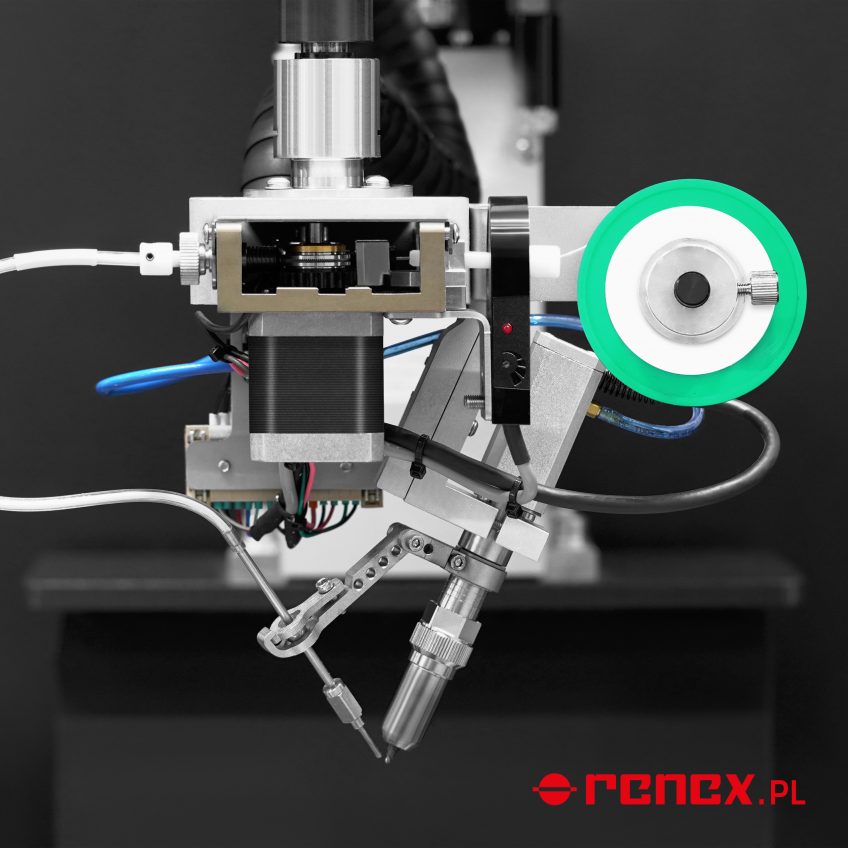

Screwdriving robot
REECO screwdriving robot allows for the automation of production steps that require the screwing of parts with screws and bolts. These processes are often used in the assembly of finished product components such as housings. The robot provides an alternative to the human labor that is still common at this stage of production. In many cases, workers still manually – using an electric screwdriver to screw in a few to dozens of screws while assembling products.
Automating this process with robots allows for significant time savings and increased productivity. The workpiece on which the work is carried out is brought into the range of the working field on the conveyor. The robot, executing the program, takes the appropriate screws from the feeder and screws them into the holes with the selected clamping force, so that full repeatability and precision are maintained, while minimizing the risk of human error.
These are just examples showing how the simple automation of parts of processes using cost-efficient SCARA robots can bring quick profits. The combination of a wider range of robots, including Cartesian, single-axis or dual-axis robots, however, offers much greater possibilities, allowing automation of not just one or two basic steps but the entire end-to-end process. LCMR200 linear conveyor module – provides programmable flexibility in transporting workpieces.
End-to-End automation
Yamaha’s line of robots enables integrators to build a complete solution consisting of an optimal combination of individual devices. One aspect to consider is always how to move workpieces – from one workstation to the next. Conventionally, this has been accomplished using belt and roller conveyors. Now, Yamaha’s unique linear conveyor modules such as the LCMR200 have changed all that by introducing a conveyor that allows speed, stop position and direction to be configured using RCX-Studio 2020, i.e. the same environment used to simulate, program and operate all YAMAHA robots. The LCMR module is capable of high-speed bi-directional movement and high acceleration as well as small movements. The system is equipped with a direct-controlled servo drive, eliminating the need for mechanical stops and position sensors normally needed to control conventional conveyors. Each slider can be programmed and controlled independently, transforming the “passive flow” of an ordinary conveyor into actively controlled transport. With individual drives built in and controlled by a YAMAHA YHX-series universal controller, conveying using LCMR modules can save about 65% of space behind the control panel and reduce connection time by up to 50%. Using RCX-Studio 2020, the transport of workpieces can be designed as an integral part of the robotic solution expanding its capabilities. Modules can be positioned to form lines in various lengths selected to suit the conditions. The LCMR200 slider can also serve as a work area, allowing processes such as mechanical assembly or electrical testing on components to be performed on it.
Selecting and programming a robot
From the outside, and even after initial familiarization, one robot may look very similar to another. When picking one, it’s important to evaluate not only the load-carrying capacity, which is easily compared in tables, but also other aspects of the design, such as speed and cycle time, power consumption and reliability. The Yamaha position sensing system used in SCARA’s YK-X series robots uses resolvers instead of typical encoders, which can be affected by contaminants such as grease or dust, or magnetic or electric fields. In addition, the beltless drive with which select models are equipped ensures consistent accuracy that does not deteriorate over time. Special models are also available, like dust- or splash-proof variants designed for use in environments such as cleanrooms and food preparation areas.
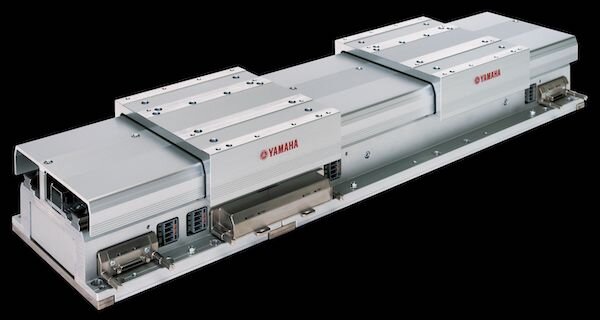
Simplified robot vision
A simple “blind” robot can satisfactorily handle a wide variety of industrial processes. However, introducing a vision system into the solution expands the possibilities for dealing with more complex processes, verifying positioning accuracy and improving quality. This is often a complex challenge that requires specialized knowledge for a vision system to communicate with a robot controller. YAMAHA brings vision to the robot programming and control environment with the iVY2+ vision system. The system includes camera modules with up to 5Mpixel resolution and camera interface cards that are compatible with RCX3 series robot controllers. Special vision manuals are also available to simplify programming with RCX-Studio 2020 and enable fast search and tracking of components.
Application of the vision system to the robot’s operation allows users to benefit from advanced features such as cluster detection, which enables identification and rapid counting of irregularly shaped objects such as food items and clothing. The iVY2+ system also includes an image edge search mechanism that improves detection of items in difficult lighting conditions. A wizard that makes it easy to calibrate the system and a simplified three-step workpiece registration process that requires the user to select only the image capture, contour and detection position settings eliminate labor-intensive tasks and help users complete setups up to 80% faster than typical general-purpose vision systems.
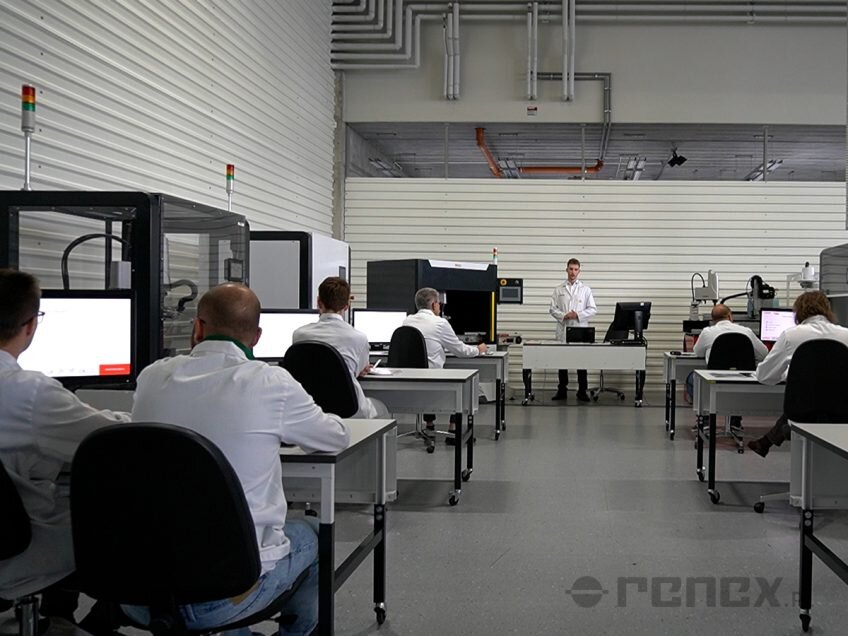
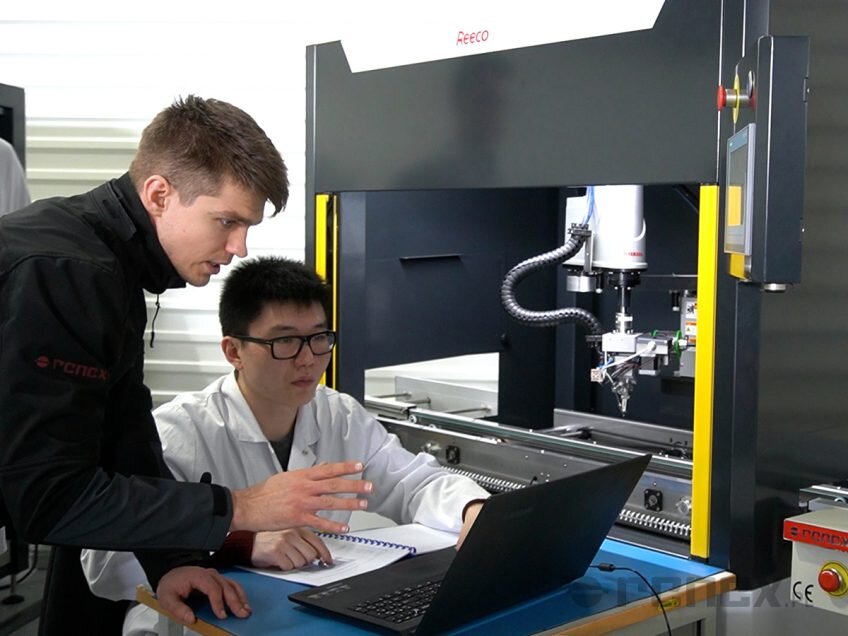
Summary
Industrial robots are now more affordable and easier to implement in manufacturing, packaging and logistics than ever before. A wide range of robot types are available, such as SCARA, Cartesian, single-axis or multi-axis, in small sizes suitable for precision tasks. Although still few robot manufacturers are able to offer all types of devices in a wide range of sizes. These additional options allow users to scale systems more easily and start automation with a small investment to test results. As experience grows, more and more processes can be robotized. With the additional design of the YAMAHA LCMR200 linear conveyor module, a complete automated assembly line can be built in a small footprint and quickly tuned using graphical programming software.
When considering the introduction of robots to automate one or more processes, it is important to consider design features that affect reliability, as well as key performance parameters such as payload, speed and energy consumption. Ensuring scalability is also critical. Integrating a robot vision system can be more complex than it appears, programming can be difficult, and interactions between the robot and camera can be slow. A solution that provides easier integration of more advanced features can be much more cost-effective in the long run.
Automation of processes such as dosing or coating can be further facilitated by off-the-shelf solutions. YAMAHA SCARA manipulators have been used in the REECO Robot series awarded with the TERAZ POLSKA emblem. It includes Soldering Robots, Screwdriving Robots and, of particular interest from the point of view of this article, Dosing and Coating Robots.
What’s next?
YAMAHA and REECO equipment and robots can be seen and tested in action at the RENEX TECHNOLOGY AND TRAINING CENTER. Within this center, the RENEX Group – which is one of the largest Polish companies in the electronics industry, as well as the distributor of YAMAHA Robotics for Poland and the Balkan countries – pursues its mission of providing comprehensive services to the electronics industry.
RENEX Group provides not only the equipment itself but also a wide range of consulting, service and training services. RENEX TECHNOLOGY AND TRAINING CENTER specialists help identify production problems and select appropriate technological solutions.
The center also provides training in the field of introduced robotic solutions. The center operates an AUTHORIZED YAMAHA TRAINING CENTER providing expertise in the operation and programming of industrial equipment and robots, allowing users to take full advantage of their capabilities.